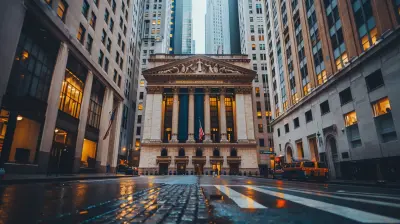The Role of Central Banks in Financial Regulation
24 November 2025
Let’s talk money—but not the way you might be thinking. We’re diving deep into the powerhouse institutions that keep the financial world from spiraling out of control: central banks. They’re like the referees in the wild game of global finance, and whether you’re a curious investor, a student of economics, or just someone who wants to understand why interest rates make headlines, this article is for you.
In today's fast-paced, interconnected financial environment, central banks are more than just money printers. They’re the backbone of monetary stability, monetary policy makers, crisis managers, and yes—financial regulators.
So, why are central banks so crucial to financial regulation? Grab a coffee (or your drink of choice), and let’s get into it.
🧠 What Is a Central Bank, Anyway?
Before we unpack their role in regulation, let’s rewind a bit.A central bank is an institution that manages a nation’s currency, money supply, and interest rates. Think of them as the financial wizards working behind the curtain. The U.S. has the Federal Reserve (the “Fed”), the European Union has the European Central Bank (ECB), and the UK rocks with the Bank of England.
They’re not commercial banks. You can’t walk into a central bank and open a checking account. Instead, they oversee and support the banking system from behind the scenes, ensuring there’s stability in the economy and that credit is available when needed.
🎛️ The Main Responsibilities of Central Banks
At their core, central banks have several key mandates:- Monetary Policy: Adjusting interest rates and controlling inflation.
- Financial Stability: Preventing market meltdowns and keeping the financial system stable.
- Lender of Last Resort: Bailing banks out when things get dicey.
- Currency Issuance: Printing and distributing the national currency.
- Regulation and Supervision: Keeping financial institutions honest, transparent, and solvent.
For this piece, we’re zoning in on that last one: regulation and supervision. Believe it or not, this is where it gets really interesting.
🛠️ Central Banks as Financial Regulators: What’s Their Job?
1. Setting the Rules
Let’s start with the basics. Central banks often write the rulebook when it comes to banking behavior. These rules might cover how much money a bank should keep in reserve, how much risk they can take, and how they report their finances.Imagine a classroom without a teacher—chaos, right? That’s what the financial system would look like without these regulators. Central banks make sure everyone follows the rules—no cheating, no excessive risk-taking, and definitely no Ponzi schemes.
Take the Federal Reserve as an example. It sets capital adequacy requirements—basically, how much capital a bank needs to hold to absorb losses. Without these rules, banks might lend recklessly, leading to another crisis like 2008.
2. Monitoring Risks in the System
Central banks are constantly scanning the horizon for danger. They analyze data, monitor financial institutions, and keep tabs on economic trends. Like radar detecting incoming storms, this helps them stay one step ahead.Why is this vital? Because risk builds quietly. It doesn’t announce itself with sirens and flashing lights. Just think about the sub-prime mortgage crisis. The risks were hidden in plain sight—until it was too late. Now, central banks keep a much closer watch on market behaviors to avoid déjà vu.
3. Stress Testing Banks
Ever wondered if banks could survive a financial apocalypse? That’s what stress tests are for. Central banks simulate economic doomsday scenarios to see if banks can withstand the pressure.These tests aren’t just academic exercises. Results can force banks to raise capital, cut risky assets, or change their strategies completely. It’s like a financial fire drill—they may never need it, but if disaster strikes, they’ll know what to do.
4. Supervising Systemically Important Institutions
Some banks are just too big to fail. Literally. If they collapse, they could take the whole financial system down with them.Central banks keep these institutions on a short leash. They require higher capital buffers, tougher oversight, and stricter scrutiny. Think of it like giving someone with a history of crashing cars more driving lessons and a safer vehicle.
This practice became much more important post-2008, when the collapse of Lehman Brothers exposed the dangers of letting such institutions operate unchecked.
🔍 How Central Banks Coordinate with Other Regulators
Central banks don’t work in a vacuum. They team up with other regulatory bodies like financial watchdogs, securities commissions, and international agencies.For example, in the U.S., the Federal Reserve works closely with the FDIC (which insures your bank deposits) and the SEC (which monitors securities markets). Globally, you’ve got the Financial Stability Board (FSB) and the Basel Committee on Banking Supervision helping countries coordinate.
Why does this matter? Because financial markets don’t respect borders. A crisis in one country can trigger a domino effect worldwide. Let’s just say when the U.S. sneezes, the whole world catches a cold. Coordination ensures everyone’s singing from the same hymn sheet.
💥 Crisis Management: The Ultimate Test
You don’t know how good your brakes are until you slam on them. Financial crises are where central banks prove their worth.Take the 2008 financial crisis again. Central banks threw everything they had at the problem: cutting interest rates to near zero, buying government bonds (quantitative easing), and providing emergency funding to banks.
More recently, during the COVID-19 pandemic, they stepped in again with rate cuts, lending programs, and market interventions. These were crucial in preventing full-scale economic collapse.
It’s in these high-pressure moments that the dual role of central banks—as monetary authorities and regulators—really shines. They don’t just react; they lead.
😬 Common Criticisms: Are Central Banks Too Powerful?
Now, let’s play devil’s advocate for a second. Not everyone’s a fan of the central bank’s regulatory muscle.Some argue they’ve become too powerful, with too little accountability. Others say central banks were asleep at the wheel during the lead-up to the 2008 crisis and only acted after the damage was done.
Plus, there’s the issue of moral hazard. If banks know the central bank will save them during a crash, aren’t they more likely to take risky bets?
These criticisms aren’t baseless. That’s why transparency, communication, and structural reform are ongoing priorities.
📈 The Evolving Role of Central Banks in a Digital Age
Fast forward to today, and central banks are facing new challenges. Cryptocurrencies, fintech startups, decentralized finance (DeFi)—the game is changing.Now, central banks are exploring digital currencies (CBDCs), regulating fintech platforms, and figuring out how to adapt traditional rules to new financial ecosystems.
They’re also grappling with climate risk, cybersecurity threats, and the growing influence of big tech companies in financial services. The mission is clear: adapt or become irrelevant.
🧩 Why Financial Regulation by Central Banks Matters to You
Alright, let’s tie this back to your day-to-day life.Do you want stable prices at the grocery store? A safe place to put your savings? Access to credit when you need a mortgage?
All of that hinges on a well-regulated financial system. Without central banks keeping an eye on things, we risk inflation spikes, banking collapses, and financial chaos.
So no, you might never meet a central banker—but trust me, you feel their work every day.
📝 Wrapping Up: The Balancing Act Continues
The role of central banks in financial regulation isn’t glamorous. You won’t see it in Hollywood blockbusters (okay, maybe “The Big Short”), but it’s foundational to economic health. They're the quiet protectors, setting the stage for growth while preventing disaster.As the financial world becomes more complex, their role will only expand. Regulation, innovation, crisis response—they’re juggling it all while walking a tightrope of public trust. It’s not an easy gig, but someone’s got to do it.
Next time you hear about the Fed raising interest rates or the ECB launching a digital euro, you’ll know—it’s more than just headlines. It’s central banks doing what they do best: keeping the system safe, stable, and (hopefully) fair.
all images in this post were generated using AI tools
Category:
Financial RegulationAuthor:

Yasmin McGee
Discussion
rate this article
1 comments
Easton Pratt
This article offers a concise overview of central banks' critical role in financial regulation. It effectively highlights the balance they must strike between stability and growth, though I would appreciate more examples of successful regulatory interventions.
November 24, 2025 at 12:54 PM


